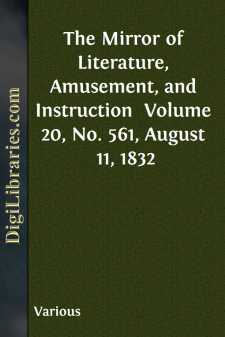Categories
- Antiques & Collectibles 13
- Architecture 36
- Art 48
- Bibles 22
- Biography & Autobiography 813
- Body, Mind & Spirit 142
- Business & Economics 28
- Children's Books 15
- Children's Fiction 12
- Computers 4
- Cooking 94
- Crafts & Hobbies 4
- Drama 346
- Education 46
- Family & Relationships 57
- Fiction 11828
- Games 19
- Gardening 17
- Health & Fitness 34
- History 1377
- House & Home 1
- Humor 147
- Juvenile Fiction 1873
- Juvenile Nonfiction 202
- Language Arts & Disciplines 88
- Law 16
- Literary Collections 686
- Literary Criticism 179
- Mathematics 13
- Medical 41
- Music 40
- Nature 179
- Non-Classifiable 1768
- Performing Arts 7
- Periodicals 1453
- Philosophy 64
- Photography 2
- Poetry 896
- Political Science 203
- Psychology 42
- Reference 154
- Religion 513
- Science 126
- Self-Help 84
- Social Science 81
- Sports & Recreation 34
- Study Aids 3
- Technology & Engineering 59
- Transportation 23
- Travel 463
- True Crime 29
The Mirror of Literature, Amusement, and Instruction Volume 20, No. 561, August 11, 1832
by: Various
Categories:
Description:
Excerpt
BURNHAM ABBEY
BURNHAM ABBEY, From a Sketch, by a Correspondent.Burnham is a village of some consideration, in Buckinghamshire, and gives name to a deanery and hundred. Its prosperity has been also augmented by the privilege of holding three fairs annually. It is situate in the picturesque vicinity of Windsor, about five miles from that town, and three miles N.E. of Maidenhead. It was anciently a place of much importance. One of the few relics of its greatness is the ivy-mantled ruin represented in the above Engraving. So late as the fourteenth century, Burnham could also boast of a royal palace within its boundary: but, alas! the wand of Prospero has long since touched its gorgeousness, so as to "leave not a rack behind."
The ruin stands about one mile south of the village, and is part of an Augustine nunnery, built in the year 1228, by Richard, Earl of Cornwall, and brother of Henry the Third. He was a vexatious thorn in the crown of Henry, whose long and confused reign, "were it not that for the first time it exhibits the elements of the English constitution in a state of disorderly fermentation, would scarcely deserve the consideration of the philosopher and the politician." One of Richard's fraternal acts was placing himself at the head of a formidable confederacy, to which Henry was obliged to yield. The papal power was at this time at its greatest height; Richard had been elected King of the Romans, and from the spoil obtained by the monstrous exactions of his court, he may be presumed to have erected the above nunnery. Of this system of pious plunder we have many proud architectural memorials; though to rob with one hand, and found religious houses with the other, reminds one of the trade of a waterman—to look one way and row the other.
The nunnery was richly endowed with several of the neighbouring manors; the remains are now used as the out-offices of an adjoining farm. Little can be traced of the "studious cloister," the "storied window," or the "high embowed roof;" but the ivy climbs with parasitic fondness over its gable, or thrusts its rootlets as holdfasts into its crumbling wall. The dates of these ruins claim the attention of the speculative antiquary. The chimney, though of great age, did not of course belong to the original building; the earliest introduction of chimneys into this country being stated, (but without proof,) to be in the year 1300. The upper window, and the arched doorway are in the early English style prevalent at the date of the foundation; the former has the elegant lancet-shape of the earliest specimens.
A DREAM OF THE BEAUTIFUL.
"Another scene where happiness is sought!
A festive chamber with its golden hues,
Its dream-like sounds, and languishing delights."
R. MONTGOMERY.
I stood in the light of the festive hall,
Gorgeously wrought was its pictured wall;
And the strings of the lute replied in song,
To the heart-breathed lays of the vocal throng.
Oh! rich were the odours that floated there,
O'er the swan-like neck and the bosom fair;
And roses were mingled with sparkling pearls,
On the marble brow, and the cluster'd curls....












